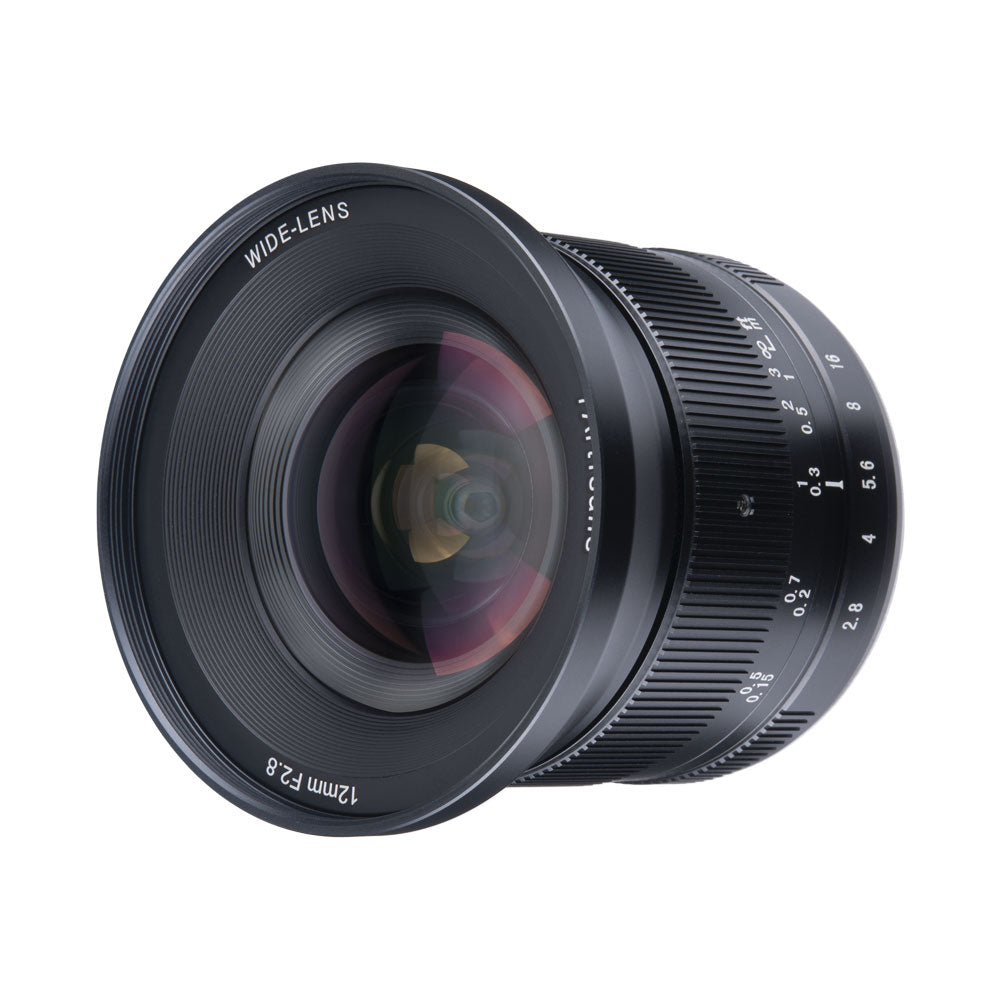The 7artisans 12mm f/2.8 Mark II lens punches way above its price bracket. This all-metal, pocket-sized lens delivers impressive sharpness at f/2.8, outperforming some Zeiss options. At under $200, it offers a 98° field of view with minimal aberrations. Sure, it's manual focus only, but Canon's built-in tools make this manageable. Perfect for architecture, scenery, and even astrophotography. Corner sharpness isn't perfect, but hey, what do you expect for this price point?
Build Quality & Design: Punching Above Its Price Point
A true wolf in sheep's clothing, the 7artisans 12MM F2.8 Mark II defies its budget-friendly price with surprisingly sturdy construction.
All-metal build quality gives this tiny Canon EF-M mount lens serious credibility. No plastic junk here.
At just 66mm long and weighing a mere 295g, it's practically pocket-sized.
Yet it feels substantial. Solid. The matte black finish? Classy and practical—no fingerprints.
Both focus and aperture rings move with satisfying precision. The de-clicked aperture ring allows for smooth, stepless adjustments when shooting video.
No wobbles or cheap feeling parts.
The built-in depth of field scale helps photographers quickly visualize their focus range without guesswork.
Sure, weather sealing is basically non-existent, but something had to give at this price point.
Optical Performance: Wide-Angle Wonder on a Budget
The solid build quality creates expectations, but in the end, this lens lives or dies by its optical performance.
Turns out, it delivers. Sharp in the center at f/2.8 (even outperforming some Zeiss glass), though corners need stopping down. Peak sharpness hits at f/5.6. After f/11? Diffraction kicks in.
Aberration control is surprisingly good—minimal coma by f/2.8 and well-controlled chromatic aberration. Night photographers, rejoice. This thing handles pinpoint lights with minimal distortion.
Sure, there's field curvature and soft corners. For astrophotography enthusiasts, this lens offers similar benefits to the Rokinon 12mm f2 with its ability to capture wide night scenes.
But for the price? A budget-friendly entry into ultra-wide photography that chooses way above its weight class. It offers tremendous value compared to premium wide-angle options costing ten times more.

Field Testing the 12mm: From Landscapes to Architecture
Most field testers put the 7artisans 12mm F2.8 Mark II through its paces in two challenging environments: panoramas and architecture.
In panoramas, the lens creates that stretched-distance feel that screams "dramatic!" But watch out—it tends to underexpose when facing bright white mountains or sky. Program mode? Good luck in high contrast scenes. The camera often prioritizes middle gray tones, resulting in darker images that require exposure compensation adjustments.
For architecture, this little manual beast shines. Its 98° field of view captures entire facades when you're backed against a wall. That constant f/2.8 aperture? Perfect for consistent exposure in dim interiors.
No autofocus motor means it's lighter than native options. No stabilization either. But hey, who needs that with such a wide lens?
Manual Focus Mastery: Techniques for the EOS M System
Manual focusing the 7artisans 12mm on an EOS M camera might seem intimidating at first.
But Canon with Magic Lantern's tools make it surprisingly manageable. Tools like Focus Peaking highlights in-focus edges instantly. Transformational.
Focus peaking isn't just a feature—it's your manual focus superpower. Sharp edges light up instantly, removing all guesswork.
For critical work, Live View Magnification is non-negotiable. Zoom in 5x or 10x to check details. Yeah, it drains the battery faster. Worth it.
Bright sunlight? Good luck seeing that LCD screen. Bring a loupe or find shade. Seriously.
Combine these tools and you'll hit focus every time. Almost.
Real-World Image Quality: Sample Gallery & Analysis
Images captured with the 7artisans 12mm f/2.8 Mark II tell an interesting visual story.
The center sharpness is good but not mind-blowing at f/2.8, with those corners looking decidedly soft. Tough luck, perfectionists.
Stop down to f/8, though, and the whole image evens out nicely.
Architecture shots appear mostly distortion-free—pretty impressive for such a wide lens—and colors stay natural without that over-saturated Instagram look.
The lens really shines with dramatic skies and buildings, thanks to its ultra-wide view.
Close focusing at 15cm? Creates some wild foreground exaggeration. Not bad for cityscape shooters on a budget.
Value Proposition: How the Mark II Compares to Competitors
The 7artisans 12mm f/2.8 Mark II enters the ultra-wide lens market with an attractive price tag that demands attention.

It's dramatically cheaper than first-party alternatives while delivering decent performance where it counts.
Sure, it's not the fastest kid on the block, Samyang's 12mm f/2 has it beat there but would need a adapter, but the f/2.8 aperture handles astrophotography reasonably well.
Yes, it's manual focus only.
Yes, corner sharpness isn't mind-blowing.
But seriously, at this price?
Videographers on EOS M, like myself, who are on a budget just scored a wide-angle win.


